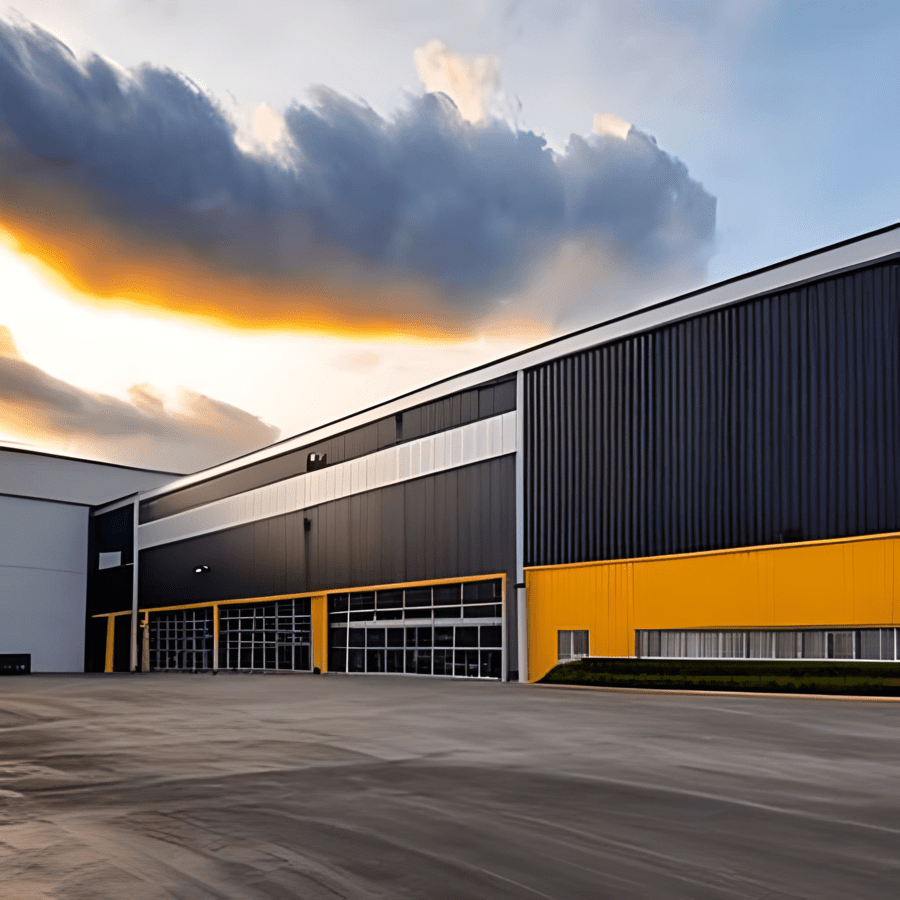Fire protection
When constructing buildings with metal structures, one of the questions that often arises is how do we protect these structures in case of fire? In this post, we will discuss the passive protection systems that allow us to guarantee the stability of the metallic structure in case of fire.
We will provide an overview of the different systems allowing us to have basic criteria on the most appropriate options for each situation. It is necessary to look into the local fire protection regulations for each of the cases, as well as the documentation of technical tests of products used in structural protection.
Fire stability of metallic structures
Basic concepts of fire stability and metal structures
It is important to know some basic concepts about the fire stability of metallic structures. I am specifically mentioning metallic structures since the protection measures are different in the case of concrete or wooden structures.
In general, all normative references on this subject in various countries refer to the following concepts:
Bearing capacity – (R, Resistance): Time in which the stability or bearing capacity is fulfilled. It is specific for those elements that perform the load-bearing function, such as beams and columns.
Integrity (EI): Time that the stability and integrity of the passage of flames, hot gases, and temperature are fulfilled. It is specific in non-load bearing separating elements such as walls, facades, firewalls, etc.
Insulation (REI): time that stability, integrity, thermal insulation (similar to the concept of fire resistance, RF), and temperature insulation are met. It is specific to separating elements that also act as load-bearing elements, such as slabs or load-bearing walls.
Fire performance of steel
Steel is a metal that changes with temperature, where strength values and its elastic limit are reduced. It has a very important plastic phase where it deforms long before breaking.
In order to achieve adequate protection of steel against fire we must know:
Critical temperature: This value is usually estimated at 500 degrees Celsius (932 F) for thick steels of classes 1, 2, and 3. It is considered that at this temperature the element may collapse. In the case of very slender sections, i.e., with high camber, the critical temperature to be considered for calculation purposes will be 350 degrees Celsius (662 F).
These values will depend on the local or state regulations for the regulation of steel elements in case of fire.
To understand the importance of knowing the critical temperature, let’s take as a reference a fire caused by the combustion of wood, paper, or plastic, the so-called cellulosic fire, in which steel can reach the critical temperature of 500 to 550 degrees Celsius (932 F to 1022F) in a time range of 15 to 20 minutes, at which point it loses its stability properties.
Shape factor concept (massiveness): this concept gives rise to the various guiding formulas for calculating the shape factor according to the geometric cross-section of the cross-sections when they are without any protection.
The analysis of the massiveness of a structure will allow us to establish a relationship between the surface area exposed to fire and the volume of the structure of a building. In this way, in simple words, it measures the greater or lesser facility that the structure has to be affected by the action of fire. The level of fire protection depends on massiveness. This factor gives the ratio of the speed with which the supporting elements of a steel-framed building will heat up in case of fire before the collapse.
The level of fire protection depends on massiveness. This factor gives the ratio of the speed with which the supporting elements of a steel-framed building will heat up in case of fire before the collapse
Methods and systems for adding fire stability to steel
Intumescent paints
The intumescent paint is designed to protect indoors, although, with the application of a specific flame-retardant polyurethane enamel, we could encapsulate the product once it is applied and dry; thus it can be used outdoors, depending on the external environmental conditions.
Its main function is to provide a degree of thermal protection to the structure, allowing a delay in the time in which it reaches the critical temperature and collapses. The calculation of the microns of paint to be applied will depend on the shape factor of the element.
There are three types of intumescent paints: water-based, solvent-based, and hybrid-based. Their use will depend on the environmental conditions and safety levels we wish to achieve. Here we can see it in more detail:
| Water-based | Solvent-based | Hybrid-based |
| Interior exposure | External exposure | On-site or workshop application |
| On-site application | On-site or workshop application | Low to zero Volatile Organic Compounds (VOCs) |
| Low to zero Volatile Organic Compounds (VOCs) | Long-lasting | Resistant to external exposure |
| No odor | Climate tolerance | A single coat is applied |
| Resistant to impacts | ||
| Reduced odor |
The main advantages of protecting steel with intumescent paints are:
- Effective fire protection
- Corrosion protection
- Excellent aesthetic finish
- Ease of maintenance
- Low impact on the weight of the structure
Mortar spraying
Perlite and vermiculite
Perlite and vermiculite mortar is a passive fire protection system applied to metal structures, although in some cases it can also be used on concrete and wood structures.
Perlite is a non-toxic, non-combustible, and very light volcanic material that contains water inside. When subjected to a grinding and expansion process, it acquires a large volume with little weight, lowering thermal and acoustic conductivity.
Vermiculite is a mineral with a laminated structure inside which, like perlite, contains water. Its great characteristic is that when heated to certain temperatures it increases its volume and expansion capacity from 8 to 20 times its original size.
The combination of these two components results in a fine-grained dry mortar that facilitates handling for application to metal structures.
As a result of a good application of the perlite and vermiculite mortar, the structure obtains, besides fire protection, good thermal and acoustic insulation.
Rock Wool
Rock wool-based mortars are all those composed of mineral wool particles of basaltic rock, inorganic hydraulic binders, and anti-dust additives.
For many years, rock wool mortars have been manufactured without the use of asbestos or any other type of toxic product.
It has a light-colored rough gray appearance, which, once set, can be painted with any coat of plastic or acrylic paint to improve its aesthetics if necessary.
Among its main characteristics are its low density (200 to 300 kg/m3 or 12.5 lb/ft3 to 19 lb/ft3), its low thermal conductivity, good acoustic behavior, and type A-1 combustibility, one of the best in terms of material classification.
Plates
Rigid and semi-rigid panels
These systems are made up of rigid and semi-rigid panels of mineral fibers or fibrosilicate coated with non-flammable material on one or both sides, sealed with non-combustible mastic at the time of installation to ensure that it is fireproof.
It allows the creation of passive barriers that are very simple to install as they can be easily cut and shaped. The panel is self-supporting, which means that it does not need any auxiliary structure for its assembly, being adaptable to different shapes. It is also a very easy system for covering ventilation ducts in the building.
One of the main advantages of this type of solution is that it is much cleaner when working on-site, and its final finish has a much better aesthetic appearance.
Some of the advantages of this system are:
- Excellent moisture and condensate resistance
- Good waterproofing
- Resistance to chemical agents
- Rot, mold, fungus, and bacteria resistant
- It is not hygroscopic and is very stable at high temperatures.
Conclusion on the fire protection of metallic structures
The protection of steel against temperature rise conditions due to fire exposure aims to delay the collapse time of the structure. In other words, it will not be possible to have 100% fire-resistant structures since, like any material, the temperature can reach a point where it collapses, but the objective of the protective systems mentioned above is to provide sufficient time for a safe evacuation of the building users.
Knowing these critical concepts of critical temperature and form factor or massiveness, as well as the purpose of the property, we will be able to select the most suitable protection system for our building, whether intumescent paints, mortar sprayed or slab systems.
We must keep in mind that the safety level for a storage facility for metal products is not the same as that applied to the storage facilities of a company that produces paper, since the latter presents a greater risk of combustion and propagation. Similarly, we cannot apply the same criteria to a factory as to a building with a large flow of people such as a hospital, shopping mall, or airport.
All of this will be defined in the local or state codes or regulations on protection measures for buildings with metal structures in case of fire.
To wrap up, a table comparing the three systems mentioned above is presented below:
| Intumescent paints | Mortar spraying | Plates |
| Cost-effective | Low costs | Moisture resistant |
| Maintains the aesthetics of the building | Useful if aesthetics is not relevant | Puede aplicarse pintura si lo estético es importante |
| Adds minimal weight to the structure | Acoustic benefits | Easy to install |
| Simple application | Paint can be added if aesthetics are important | Environmental factors don’t interrupt the installation |
| Short application time | ||
| Easy to apply in complex structures |
Disclaimer: This blog post is not intended as a guide nor advice on the use and installation of construction materials and should never be taken as such. All use and installation of fire protection materials or any other type of building materials, products, and equipment must be done under the supervision of a qualified and accredited professional in your locality.

